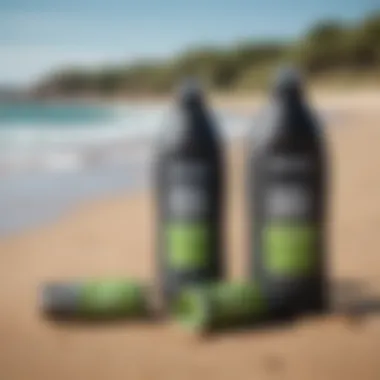Essential Neoprene Cleaners for Surf Gear Care


Intro
Maintaining surf gear is vital for performance and safety. One such component that often goes unnoticed is neoprene, a material widely used in wetsuits and other surf products. The right cleaning practices can prolong the lifespan of this gear, ensuring every surf session remains enjoyable and problem-free. In this guide, we will discuss the essentials of neoprene cleaners, their significance, as well as practical techniques for caring for surf equipment.
Understanding Neoprene Materials
Neoprene is a synthetic rubber that offers excellent insulation and flexibility, making it ideal for wetsuits. Over time, salt, sand, and body oils can create a grimy buildup on neoprene surfaces, which hampers performance and can even lead to the premature deterioration of the material. By understanding various neoprene types and the importance of cleaning them, surfers can maintain their equipment effectively.
The Science Behind Cleaning Agents
Not all cleaners are created equal, and that's where the science comes into play. Neoprene needs specialized cleaning agents that work to break down salt and grime without compromising the material's integrity. Look for pH-balanced solutions that do not contain harsh chemicals. This ensures your surf gear remains intact, allowing for optimal performance in the water.
Selecting the right cleaning agent can significantly enhance the durability of neoprene-based surf gear. Choose wisely!
Practical Cleaning Techniques
- Rinse Immediately After Use: One of the simplest ways to maintain neoprene is to rinse it with fresh water right after surfing. This removes salt and minimizes buildup.
- Use Mild Detergents: Regular laundry detergents can be too harsh. Instead, look for specialized neoprene cleaners or natural soap to avoid damaging your gear.
- Air Dry, Don’t Machine Dry: While it’s tempting to speed up the drying process, using a dryer can ruin the neoprene. Hang it to dry away from direct sunlight for the best results.
- Store Properly: When not in use, hang your wetsuit or store it in a cool, dry place. This prevents folds and creases that can weaken the material over time.
Environmental Considerations
With growing concerns over environmental impact, many surfers are becoming more conscious about how cleaning products affect their surroundings. Opting for biodegradable, eco-friendly cleaners can help minimize this impact. This not only protects your gear but also contributes to preserving our beautiful oceans and beaches.
Product Recommendations
When it comes to choosing neoprene cleaners, several products stand out:
- O'Neill Wetsuit Cleaner: Known for its gentle formula, it effectively breaks down salt and odors without damaging the material.
- Rip Curl Neoprene Shampoo: This product is tailored for surf gear; it cleans while conditioning neoprene.
- Aquaseal Wetsuit Cleaner: It’s versatile, tackling not just neoprene but also other materials used in surf equipment.
In summary, with the right knowledge and tools, maintaining neoprene surf gear becomes a less daunting task. By prioritizing cleanliness and using suitable products, surfers can extend the life of their equipment while keeping the environment in mind. Let's dive deeper into the various aspects of neoprene care to ensure your surf sessions remain smooth and enjoyable!
Understanding Neoprene
Understanding neoprene is an essential first step for surf enthusiasts who want to extend the quality and lifespan of their surf gear. It’s important to appreciate what this material is, as it plays a critical role in the performance and durability of wetsuits, boots, and other surf-related items.
Neoprene is a type of synthetic rubber that’s prized for its unique properties, particularly its flexibility and insulation. For surfers, this translates to warmth in chilly waters while allowing for a robust range of movement, which is vital when you’re riding waves.
Moreover, comprehending the different types of neoprene used in surf gear can significantly affect your choice of equipment and maintenance practices. Every surfer has their own needs, and the type of neoprene matters when it comes to comfort, performance, and care.
What is Neoprene?
Neoprene is a synthetic polymer known for its water-resistant properties and durability. Originally developed as a substitute for rubber in the 1930s, it quickly found its niche in a variety of applications, from industrial uses to sports gear. Its molecular structure provides insulation, making it ideal for thermal protection, which is why it’s a staple in surfing.
Engaging with neoprene is akin to understanding the fabric of the ocean itself; it adapts, stretches, and withstands the elements while providing necessary comfort to surfers in demanding conditions.
Types of Neoprene in Surf Gear
For those who surf, knowing the type of neoprene in their gear can be a game changer. Generally, neoprene is categorized into two main types: closed cell and open cell. Each comes with distinct properties that cater to specific surfing environments and styles.
Closed Cell Neoprene
Closed cell neoprene features tiny bubbles trapped within a matrix, creating a buoyant and insulating layer. This kind of neoprene is much denser, leading to less water absorption, making it a popular choice for wetsuits designed for colder waters.
The key characteristic of closed cell neoprene is its high insulation capacity while keeping the suit lightweight. This advantage allows surfers to navigate frigid ocean temperatures without compromising agility. However, one must also consider its less flexible nature compared to open cell neoprene, which can be a limiting factor in extreme performance.
Open Cell Neoprene
On the other hand, open cell neoprene has a porous structure that absorbs water, allowing for enhanced flexibility. This makes open cell neoprene incredibly comfortable, especially when worn snugly. The exception is the thermal warmth; it’s best suited for milder climates as it lets water in quite easily, which can lead to quicker cooling during colder surf sessions.
The unique feature of open cell neoprene is its softness and adaptability, making it a go-to for surfers who prioritize comfort. However, the downside is that it requires more rigorous maintenance to prevent odor and deterioration since it tends to retain moisture.
Benefits of Neoprene for Surfers
The benefits of neoprene for surfers are manifold. Primarily, it provides unparalleled thermal insulation, keeping the body warm during prolonged exposure to cold waters. Moreover, its water-resistant nature reduces drag, allowing for a smoother ride. The flexibility of neoprene supports unrestricted movement, essential for executing various maneuvers on the board.
Therefore, understanding neoprene is not just an academic exercise but a practical necessity for anyone serious about maintaining their surf gear. A solid grasp of its properties and types results in better gear choices and effective maintenance strategies, prolonging the life of one’s equipment and enhancing overall surfing experiences.
The Dirty Truth: Reasons to Clean Neoprene
Cleaning neoprene is not just about having gear that looks spick and span; it's about maintaining the quality and functionality that surfers depend on. Surfing involves a lot more than the thrill of catching waves; it’s about keeping your equipment in top shape for those frosty early mornings and salt-laden afternoons. Let’s break down why this cleaning ritual is essential.


Saltwater and Sand Accumulation
Saltwater and sand are like uninvited guests who stick around long after the party's done. After a day of riding the waves, your wetsuit, booties, and other neoprene gear become soaked with saltwater that can wreak havoc on the material if not addressed.
When neoprene is exposed to the high salinity of seawater and paired with the tiny grains of sand collected on your runs, it can lead to wear and tear that diminishes performance. Salt attracts moisture, and over time, this can contribute to the breakdown of neoprene fibers, leading to loss of insulation and flexibility.
Bacteria and Odor Control
No one wants to be the surfer whose gear has taken on an unexpected, less-than-pleasant aroma. Over time, the combination of sweat, water, and organic material can create a perfect storm for unwanted bacteria to flourish. These bacteria love a warm, damp environment, and neoprene provides just that, promoting a breeding ground for odors. Cleaning helps eliminate bacteria that can lead to smells, ensuring not only a fresher scent but also prevents possible skin irritations that can come from prolonged exposure to such germs and fungi.
Prolonging Equipment Lifespan
Preserving your gear isn't just a practical approach; it’s a sustainable choice that helps your wallet in the long run. Let’s peek into two major facets that contribute to this prolonged lifespan:
Preventing Deterioration
Preventing deterioration is key in taking sterling care of your neoprene gear. The material inherently has a lifespan, but neglecting it can significantly shorten it. Deterioration can occur due to factors such as repeated exposure to sunlight, moisture, and the previously mentioned saltwater and sand.
Using a gentle neoprene cleaner can mitigate this damage. It nourishes the material, maintaining its structural integrity. A well-maintained wetsuit, for instance, not only serves as a better insulator but can withstand the rigors of ocean adventures for a longer time, reducing the need for frequent replacements. This not only saves money but also cuts down on waste—a win-win.
Maintaining Flexibility
Flexibility in neoprene gear is paramount for any surfer. Over time, without proper cleaning and drying methods, neoprene can become stiff and lose its form, impacting your performance in the water. Maintaining flexibility allows for better movement and comfort while paddling or performing tricks. The character of neoprene itself dictates that it needs to be looked after. Regular cleaning, especially with the right products, can ensure that flexibility is kept intact. Surfers will find that a cleaner wetsuit is not just fresher smelling, but allows for the kind of movement that makes riding waves a joy—not an obligation!
In summary, caring for your neoprene gear transcends aesthetic appeal; it’s a necessity for longevity and performance. Addressing these critical concerns ensures that the things you rely on for your passion are ready to take the brunt of the next big wave. Who would want to be caught short because their cleaning game wasn't up to snuff?
Choosing the Right Neoprene Cleaner
Choosing the right neoprene cleaner is crucial in maintaining the integrity and longevity of your surf gear. With the right cleaner, you can not only keep your equipment looking fresh but also enhance its performance in the water. Considering that neoprene is a sensitive material, the wrong cleaner can damage it, leading to quicker wear and tear. When you know what to look for, making a choice becomes a lot clearer, especially when faced with the many options in the market.
Types of Neoprene Cleaners
Liquid Cleaners
Liquid cleaners have become a go-to for many surfers because they offer thorough cleaning capabilities. One of their key characteristics is their deep penetration, which allows them to reach dirt and contaminants that might be clinging to your wetsuit or other neoprene gear. This is particularly useful for tackling stubborn salt and sand residue that sprout up after a day at the beach.
A unique feature of liquid cleaners is their versatile application. Users can either dilute them with water or use them undiluted for tougher stains. However, one should note that overuse can lead to residue build-up, possibly affecting the neoprene if not rinsed properly.
Spray Cleaners
Spray cleaners are favored for their convenience and ease of use. A simple mist and wipe can provide quick and effective cleaning, making them a popular choice for those who might not have the time for a more involved cleaning routine.
The standout characteristic of spray cleaners is their ready-to-use formula, which can be sprayed directly onto the gear, requiring minimal effort. These cleaners excel in odor removal and surface cleaning but may not be as effective on deeply embedded grime compared to their liquid counterparts. Keep in mind that while they’re fantastic for quick clean-ups, they might not replace thorough cleaning sessions entirely.
Eco-Friendly Options
As surfers often swim in nature's waters, the impact of traditional cleaning products on the environment is becoming a concern. Eco-friendly options are tailored to minimize environmental harm. They use biodegradable components and usually avoid harsh chemicals that could disturb marine life, positioning themselves as responsible choices for any surfer looking to extend their eco-conscious lifestyle.
The defining quality of these cleaners is their plant-based ingredients, which are typically gentler on neoprene and skin. These products can safeguard delicate ecosystems while also keeping your gear fresh. However, it’s wise to verify that they still meet the necessary cleaning efficacy, as some might be less potent in breaking down tough stains.
What to Look for in a Neoprene Cleaner
pH Balance
When selecting a neoprene cleaner, pH balance is a key element to consider. A balanced pH helps ensure that the cleaner won’t strip essential oils from the neoprene, which can cause drying or cracking over time. This characteristic is especially vital in maintaining the flexibility and resilience of your gear.
A well-balanced cleaner tends to leave neoprene feeling soft and pliable post-cleaning, helping it stay in good shape for those exhilarating waves you love. Always check the label or product details to confirm pH suitability, as it can greatly influence the overall health of your surf equipment.
Odor Neutralization
Another aspect worth considering is odor neutralization. It can make a world of difference, especially for surfers who spend extended periods in the ocean. A good neoprene cleaner won’t just wash away dirt; it should effectively neutralize unpleasant smells as well.
With cleaners designed for odor control, your wetsuit will feel fresher on every outing. These products typically contain agents that break down odor-causing bacteria, which is a significant advantage after a long day of water sports. However, not all products might provide long-lasting odor relief, so it’s good to look for reviews or feedback from other surfers.
Sustainable Ingredients
In an era where sustainability is crucial, opting for cleaners that boast sustainable ingredients is vital. These components often derive from renewable resources and are designed to be biodegradable, thus lessening their environmental footprint.
Using sustainable ingredients in your cleaner means you can contribute positively to the environment while still caring for your gear. Many eco-friendly products come with certifications that assure consumers of their commitment to sustainability. On the downside, some eco-friendly cleaners may carry a higher price tag, necessitating a careful evaluation of quality vs cost.
"Investing in a sustainable cleaner means you preserve not just your gear but the ocean as well."


By choosing the right neoprene cleaner and considering all these factors, surfers can maintain their essential equipment while being kind to the environment.
How to Clean Neoprene Gear Effectively
Cleaning neoprene gear is essential for maintaining its integrity and extends the life of surf equipment. By effectively cleaning your gear, you uphold its performance, comfort, and protect against harmful bacteria and odors. Surfers, instructors, beach lifeguards, and outdoor writers need to keep their gear in top shape, as it can directly impact the quality of their time spent in the water. A sound cleaning practice helps prevent the degradation that can occur from neglecting routine care.
Step-by-Step Cleaning Process
Cleaning neoprene gear should be approached with a careful method to ensure the material is not damaged. Below is a concise step-by-step guide to help you along:
- Rinse Thoroughly: Start by rinsing your gear in cold, clean water directly after each surf session. This removes any salt, sand, or debris that might cling to it.
- Use the Right Cleaner: Choose a neoprene cleaner as mentioned earlier. Ensure it is specifically designed for this type of material to avoid weakening it.
- Apply the Cleaner: Dampen a soft cloth or sponge with the cleaner, then gently scrub the interior and exterior of the gear. Focus on areas that see more wear and tear.
- Rinse Again: After cleaning, rinse the gear thoroughly with cold water to wash away any residual cleaning agent.
- Dry Properly: Move on to the drying process, which is equally important to maintain the neoprene's flexibility and condition.
Drying Methods
When it comes to drying neoprene, the method matters just as much as cleaning to prevent damage and maintain elasticity.
Avoiding Direct Sunlight
Direct sunlight can wreak havoc on neoprene. Exposure to its harsh rays may lead to fading and the material becoming brittle. It’s best to dry your gear in a shaded area or indoors, as this will help maintain the integrity of the color and elasticity. Not only does it keep your gear looking fresh, but it also ensures that the neoprene remains responsive and doesn’t age prematurely, which enhances its longevity. Opting for this method might take longer, but when it comes to your surf gear, patience pays off in the long run.
Air Drying vs. Tumble Drying
Air drying is usually favored over tumble drying for neoprene. While tumble drying offers quick results, the heat from dryers can cause significant damage to the material, leading to a loss in flexibility and shape. Key characteristic of air drying is that it allows the neoprene to dry naturally at its own pace. You can hang the gear on a sturdy hanger or lay it flat on a towel, avoiding creases and folds. Of course, air drying takes time—typically a few hours—but it’s a small price to pay for the safety of your essential equipment. It’s a method that surfers have sworn by for years, ensuring that their gear stays as good as new.
"Proper maintenance is not just about keeping it clean; it’s about preserving the entire surfing experience for years to come."
Common Mistakes When Cleaning Neoprene
Maintaining neoprene gear is no walk in the park, and cleaning it the right way can make or break the longevity of your precious equipment. Surfers often overlook some critical aspects when caring for their gear, leading to costly mistakes. Understanding these common pitfalls can help ensure that your wetsuit, booties, or any other neoprene item stays in peak condition, ready for your next session on the waves.
Using Harsh Chemicals
One of the biggest blunders surfers make is reaching for aggressive cleaning agents. Chemicals like bleach or other strong solvents can wreak havoc on neoprene. While the intent is to get rid of odors or stains, the reality is that these substances break down the material and compromise its integrity. Over time, this can lead to tears, leaks, or loss of elasticity.
Instead, opt for cleaners specifically formulated for neoprene. These products work without damaging the material, helping keep your gear perfect for catching those waves. Remember, when in doubt, gentle is the name of the game.
"Choosing the right cleaner isn't just about ease; it directly impacts the life of your beloved gear."
Ignoring Care Labels
Every piece of neoprene gear comes with a care label that provides vital information on how to handle and clean it. Many surfers tend to toss the labels aside, believing they already understand the cleaning process. This could be a big mistake. Overlooking the instructions may lead to improper cleaning techniques, such as using the wrong temperature for washing or failing to dry as recommended.
Taking a moment to read the labels can save you from future headaches. Each piece of gear is unique, and manufacturers design these labels to help you maintain your equipment effectively. Paying attention to them can ensure that you get maximum use out of your gear and keep it looking fresh.
Over Washing
Another common mistake is over-washing neoprene gear. It's tempting to rinse off your wetsuit after every use, especially after a long day filled with saltwater and sand. However, frequent washing can strip the material of essential oils that maintain its flexibility and moisture resistance. Like a well-oiled machine, your gear benefits from a bit of natural wear and tear.
Instead of frequent washes, focus on spot cleaning after sessions and reserve full washings for times when it’s genuinely necessary. This not only helps the material last longer but also reduces the environmental impact from excessive detergent use.
Maintaining Neoprene: Beyond Cleaning
When it comes to neoprene, keeping gear clean is just part of the equation. But why stop at cleaning? Maintenance is an ongoing relationship that involves not just washing but also storing and inspecting your gear to ensure it lasts as long as you do. We're talking about proper practices that help in preserving the elasticity and form of neoprene, as well as ensuring that it performs when you hit the waves. After all, it’s an investment in both time and money.
Good maintenance can prevent small issues from snowballing into big problems. For instance, ignoring the signs of wear and tear can lead to costly repairs or even replacement. Think of it like a car; regular check-ups catch potential problems early. Hence, taking a proactive approach in caring for neoprene gear can drastically extend its lifespan and efficacy.
Proper Storage Techniques
Properly storing neoprene gear is essential, particularly when the surf season winds down. Your equipment shouldn't just be tossed into a closet, left to gather dust. Instead, treat it as you would any valuable item. Here are some techniques:
- Avoid tight rolls: When storing wetsuits, fold them loosely instead of rolling them up tightly. This minimizes stress on the material, preventing creases and warps.
- Keep it cool: Store your gear in a cool, dry place. Excessive heat can lead to degradation over time. Think of a soft drink left in a hot car; it doesn't take long before it’s no longer refreshing.
- Avoid direct sunlight: UV rays can be particularly harsh on neoprene, causing it to break down. A dark storage bin or a closet can help protect your gear.
- Hang it properly: Use a wide hanger designed for wetsuits to hang your gear. This way, the material isn't overstretched, and gravity does its job without causing wear.
In summary, these storage techniques not only keep your neoprene gear in top shape but also ready to go when you are.
Routine Inspection and Repairs
Inspection may not sound as thrilling as catching waves, but it’s a must. Regular check-ups of your neoprene gear can uncover small damages before they become ride-ending problems. Here’s what to focus on:
- Check for tears or abrasions: Look for any holes, jagged edges, or signs of wear that can compromise the suit.
- Inspect the seams: Often, it’s the stitches that wear out first. A small rip in the seam could lead to larger issues down the line.
- Don’t forget about the zippers: Make sure they’re functioning properly and aren’t jammed with sand or other debris. Lubricate them if necessary – think of it like oiling the wheels of your bike.
- Patch up when needed: If you find small rips, use a neoprene adhesive to patch them. This quick fix is better than waiting and risking more extensive damage.


Routine inspection and timely repairs can save you from expensive replacements and also make your next surfing experience that much more enjoyable. Following these practices will ensure that your gear is ready to take on whatever the water throws your way.
Environmental Impact of Neoprene Cleaners
Addressing the environmental impact of neoprene cleaners is crucial for surfers and those involved in marine activities. The surf industry is increasingly aware of its ecological footprint, particularly the products we use to maintain gear. Neoprene, while advantageous for its buoyancy and thermal insulation, poses specific environmental challenges. Understanding these impacts helps surfers make informed choices about their cleaning products, which can ultimately contribute to a healthier planet.
Sustainability Concerns
Using neoprene cleaners often means grappling with a host of sustainability issues. Many traditional cleaners contain chemicals that may harm marine life and ecosystems. The surf community has a deep connection with oceans and beaches, so the implications of toxic runoff are all the more significant.
For example, certain surf cleaners can leach harmful substances into the water. As fish, coral reefs, and other aquatic organisms play essential roles in maintaining marine biodiversity, we ought to be cautious regarding the products we choose. It's worth noting that manufacturers are under pressure to create formulations that minimize environmental damage while still offering effective cleaning capabilities.
A few factors to consider when evaluating the sustainability of neoprene cleaners include:
- Ingredients: Look for biodegradable or non-toxic options.
- Packaging: Eco-friendly packaging that reduces plastic waste can also make a difference.
- Manufacturer practices: Research if the brand prioritizes sustainable sourcing and production methods.
It's becoming increasingly clear that opting for more sustainable neoprene cleaners isn't just a sales pitch—it's a commitment to preserving our beloved ocean playgrounds.
Biodegradable Alternatives
Emerging in response to the complexities of eco-friendly cleaning solutions are biodegradable alternatives. These cleaners are designed to break down naturally over time, significantly reducing their impact on the environment compared to conventional chemical products.
Biodegradable cleaners** typically use plant-based ingredients that effectively clean without leaving harmful residues. **Here are some notable attributes of biodegradable alternatives:
- Effective cleaning power: Many are just as effective at removing dirt and grime.
- Safety for aquatic life: These cleaners minimize risks to marine organisms, significantly reducing chemical exposure in waters.
- User-friendly: Often easy to use and available in various forms like sprays or liquids.
While these options may not have traditionally been at the forefront, their rise in popularity signifies a shift towards better practices. It's a win-win for surfers, allowing them to keep their equipment in top condition while being good stewards of the environment.
"Choosing biodegradable options not only serves your personal interests as a surfer but also benefits the ecosystems you relish."
Choosing Sustainable Neoprene Cleaners
When it comes to caring for your surf gear, choosing sustainable neoprene cleaners isn’t just a wise decision; it’s a chance to make a positive impact on the environment. Surfers are often the guardians of the oceans, and extending that ethos to every detail of their gear maintenance is paramount. Sustainable options help ensure that harmful chemicals are not released into the water system, subsequently harming marine life.
Benefits of Sustainable Cleaners
Sustainable neoprene cleaners often utilize natural ingredients that are biodegradable and less toxic. This means that not only do they preserve the integrity of your gear but also protect aquatic ecosystems. By opting for these eco-friendly products, you minimize your carbon footprint while also enjoying the peace of mind that comes with knowing that your cleaning practices are safe for the environment.
Moreover, many sustainable cleaners are formulated with strong cleaning capabilities without the need for harsh chemicals. This aspect is essential, as it helps in maintaining the flexibility and longevity of neoprene materials.
"Choosing eco-friendly products is not just a trend; it’s a necessity in preserving our planet’s health."
The integration of sustainability into your cleaning routine reflects a broader commitment to environmental stewardship. It also encourages the manufacturers to improve their formulations and contribute positively towards eco-friendly practices.
Brands Emphasizing Eco-Friendliness
A handful of brands have positioned themselves as pioneers in eco-friendly neoprene cleaner production. Some noteworthy names include:
- Nikwax: Renowned for their commitment to environmentally safe products, they’ve developed cleaners that not only clean but also enhance the lifespan of neoprene gear.
- Revivex: This brand focuses on creating effective cleaning and treatment solutions that aim for a minimal environmental impact.
- Eco-Kleen: A relatively new player, they offer plant-based cleaners that tackle stubborn stains while being gentle on your equipment and the planet.
These brands emphasize sustainable practices, from sourcing materials to packaging. Checking for product reviews and user experiences can also give insights into their efficacy and real-world impact on neoprene care.
Certifications to Look For
When venturing into the realm of sustainable cleaning products, recognizing certain certifications can help steer you towards the right choice. Here are a few notable labels:
- Green Seal: This certification indicates that the product meets rigorous standards for human health and environmental impact.
- EcoLogo: Products with this certification have been vetted for a low environmental footprint and safe ingredient selection.
- Cradle to Cradle: This certification signifies that a product is designed with sustainability in mind at every stage of its lifecycle.
Being aware of these certifications allows you to make informed decisions. Reading labels and understanding their implications can help you select a cleaner that not only meets your gear's needs but also aligns with ethical values.
In summary, selecting sustainable neoprene cleaners is an important step in maintaining both your surf gear and the environment. By supporting brands committed to eco-friendliness and being diligent in your product choices, you contribute to a more sustainable future without sacrificing effectiveness or quality.
End: The Importance of Neoprene Maintenance
When it comes to surf gear, the significance of maintaining neoprene cannot be overstated. This material, favored for its flexibility and durability, plays a crucial role in a surfer's experience, from providing warmth to ensuring safety. Failure to uphold proper care can result in diminished performance, leading to discomfort and potential hazards in the water.
Benefits of Regular Maintenance
Maintaining your neoprene gear is not just about cleaning; it's about preserving its integrity. Regular maintenance provides several advantages:
- Enhanced Performance: Clean gear functions better. A well-maintained wetsuit retains its insulation properties, allowing surfers to stay warm even in chilly waters.
- Longevity: Just like any other gear, neoprene benefits from TLC. Consistent upkeep can extend the life of your suit, saving money in the long run.
- Odor Control: Saltwater and bacteria can seep into the material, leading to unpleasant smells. Regular cleaning can prevent this issue, ensuring that your gear remains fresh.
Considerations for Maintenance
There are critical considerations when it comes to maintaining neoprene. Choosing the right cleaning agents is essential. Many common household cleaners can harm the delicate structure of neoprene, degrading its performance and lifespan. Opt for specially formulated neoprene cleaners that not only clean but also respect the integrity of the material.
“A penny for your thoughts is great, but a little extra effort in maintaining your neoprene gear can lead to a fortune of enjoyment on the waves.”
Proper storage is another vital aspect. Whenever not in use, store your gear in a cool, dark place, avoiding direct sunlight which can cause fading and cracking. Hanging your wetsuit instead of folding it helps maintain its shape and elasticity.
Conclusion
In a nutshell, treating neoprene with the respect it deserves is not just wise, but necessary. The little things, such as cleaning properly, choosing the right products, and storing your gear correctly, can yield substantial benefits both on and off the surf. An investment in maintenance is an investment in an enjoyable and safe surfing experience. Embrace this practice, and you will find yourself not just ready for the waves, but fully equipped to master them.















